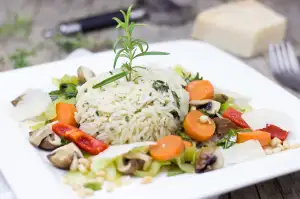Whisk Up a Batch of Homemade Buttermilk: A Simple Recipe to Savor the Creamy Delights

- Understanding the science behind buttermilk fermentation
- Gathering the necessary ingredients and equipment
- Step-by-step instructions for making buttermilk at home
- Pouring milk into a clean glass jar
- Adding a culture starter or acidifying agent
- Mixing well and covering the jar with a breathable cloth
- Allowing the mixture to ferment at room temperature
- Checking for signs of fermentation and determining readiness
- Storing and using homemade buttermilk
- Transferring the buttermilk to a sealed container
- Refrigerating the buttermilk to prolong its shelf life
- Incorporating buttermilk into various recipes
- Tips and tricks for making the best homemade buttermilk
Buttermilk, a creamy and tangy liquid, is not only a refreshing beverage on its own but also a versatile ingredient in countless recipes. Traditionally, buttermilk was the leftover liquid after churning butter from cream. However, modern buttermilk is typically made by fermenting milk with lactic acid bacteria. This fermentation process gives buttermilk its distinctive tang and creamy texture. From fluffy pancakes to tender cakes and savory dressings, the addition of buttermilk adds depth of flavor and moisture to a wide range of dishes. Its versatility makes it an essential ingredient for any passionate cook or baker. So why not whisk up a batch of homemade buttermilk and unlock the potential of this delightful dairy product in your culinary creations?
Understanding the science behind buttermilk fermentation
Understanding the science behind buttermilk fermentation is key to successfully making it at home. Buttermilk is a cultured dairy product that undergoes fermentation, transforming regular milk into a tangy and creamy delight. This process occurs when bacteria, such as Lactobacillus, convert lactose (milk sugar) into lactic acid. The lactic acid gives buttermilk its characteristic tangy flavor and thick texture. This fermentation also helps break down proteins in the milk, resulting in a smoother consistency. The presence of these beneficial bacteria makes buttermilk easier to digest and enhances its nutritional value. So, by understanding the science behind buttermilk fermentation, you can appreciate how this simple process turns ordinary milk into a versatile ingredient for your culinary creations.
Gathering the necessary ingredients and equipment
To make homemade buttermilk, you will need a few simple ingredients and equipment. First, gather fresh whole milk, preferably organic or raw, as it produces the best results. You will also need a clean glass jar with a tight-fitting lid to ferment the buttermilk. Additionally, you'll need a culture starter such as buttermilk from a previous batch or acidifying agents like lemon juice or white vinegar. Lastly, have a breathable cloth like cheesecloth or coffee filter to cover the jar during fermentation. With these basic ingredients and equipment in hand, you're ready to start whisking up your own batch of creamy homemade buttermilk!
Step-by-step instructions for making buttermilk at home
a. Start by pouring fresh milk into a clean glass jar, leaving some room for fermentation.
b. Add a culture starter like buttermilk from a previous batch or an acidifying agent like lemon juice or vinegar.
c. Mix the milk and starter well, ensuring they are thoroughly combined.
d. Cover the jar with a breathable cloth, such as cheesecloth or a coffee filter, to allow air circulation.
e. Let the mixture ferment at room temperature for 12-24 hours, depending on desired tanginess.
f. Check for signs of fermentation, such as thickening and a slightly sour smell.
g. Once fermented to your liking, your homemade buttermilk is ready to use in recipes or be stored.
Note: The process may vary slightly depending on the culture starter used, so follow specific instructions accordingly.
Pouring milk into a clean glass jar
To start making homemade buttermilk, begin by pouring fresh milk into a clean glass jar. It is important to use whole milk for the best results as it contains a higher fat content. The amount of milk you pour will depend on how much buttermilk you want to make. Fill the jar about three-quarters full, leaving some space for the fermentation process. Make sure the jar is clean and sterilized to prevent any unwanted bacteria from interfering with the fermentation process.
Adding a culture starter or acidifying agent
Adding a culture starter or acidifying agent is a crucial step in making homemade buttermilk. There are two common options for this: using a culture starter or an acidifying agent. A culture starter, such as buttermilk from a previous batch or store-bought buttermilk, contains live bacteria that will help ferment the milk. Alternatively, you can use an acidifying agent like lemon juice or white vinegar to create the acidic environment necessary for fermentation. Both options work effectively in transforming regular milk into tangy and creamy buttermilk.
Mixing well and covering the jar with a breathable cloth
After adding the culture starter or acidifying agent to the milk, it is important to mix well. Use a clean spoon or whisk to thoroughly incorporate the starter into the milk. This will ensure that the fermentation process begins evenly throughout the mixture. Once mixed, cover the jar with a breathable cloth. This allows air circulation while preventing any contaminants from entering the jar. The breathable cloth also helps in releasing excess moisture during fermentation.
Allowing the mixture to ferment at room temperature
Allow the mixture to ferment at room temperature for about 12 to 24 hours. During this time, the bacteria in the culture starter or acidifying agent will convert lactose into lactic acid, giving buttermilk its tangy flavor and thick consistency. The fermentation process also helps break down proteins and makes the buttermilk easier to digest. Keep the jar undisturbed and avoid exposing it to direct sunlight or extreme temperatures. Fermentation time may vary depending on room temperature and desired tanginess.
Checking for signs of fermentation and determining readiness
After allowing the milk and culture starter to ferment at room temperature for about 24 hours, it's time to check for signs of fermentation and determine if the buttermilk is ready. The mixture should have thickened slightly and developed a tangy aroma. To check the consistency, gently tilt the jar – if the liquid moves slowly and as a cohesive mass, it indicates successful fermentation. Additionally, a thin layer of yellowish liquid (whey) may separate on top. Taste a small amount to ensure it has a pleasantly tangy flavor. Once these signs are present, your homemade buttermilk is ready to be used in your favorite recipes!
Storing and using homemade buttermilk
Storing and using homemade buttermilk is a breeze. After the fermentation process, transfer the buttermilk to a sealed container to maintain its freshness. Refrigerate it promptly to prolong its shelf life for up to two weeks. The tangy goodness of homemade buttermilk can be incorporated into various recipes like pancakes, biscuits, dressings, and marinades. Experiment with this versatile ingredient and elevate your culinary adventures to new heights.
Transferring the buttermilk to a sealed container
Transferring the buttermilk to a sealed container is an important step to ensure its freshness and longevity. Once the fermentation process is complete, carefully pour the homemade buttermilk into a clean, airtight container. It is recommended to use glass or food-grade plastic containers with tight-fitting lids. This will prevent any contamination and help maintain the tangy flavor of the buttermilk. Remember to leave some headspace in the container as the buttermilk may expand slightly during storage. Label the container with the date of preparation for easy reference. By sealing it tightly, you can store your homemade buttermilk in the refrigerator for up to two weeks, allowing you to savor its creamy delights in various recipes whenever you desire.
Refrigerating the buttermilk to prolong its shelf life
After making a batch of homemade buttermilk, it's important to store it properly to ensure its freshness and longevity. To prolong the shelf life of your buttermilk, transfer it to a sealed container. A glass jar with a tight-fitting lid works well for this purpose. Make sure the container is clean and dry before pouring in the buttermilk. Once sealed, refrigerate the buttermilk immediately. The cold temperature will slow down any further fermentation and help maintain its tangy flavor. Properly stored, homemade buttermilk can last for up to two weeks in the refrigerator.
Incorporating buttermilk into various recipes
Incorporating buttermilk into various recipes is a delightful way to enhance the flavors and textures of your dishes. Its tangy and creamy nature adds a unique twist to both sweet and savory recipes. Use buttermilk as a marinade for chicken or pork, resulting in tender and flavorful meat. It also works wonders in baked goods like pancakes, biscuits, and cakes, lending them a moist and tender crumb. Buttermilk can even be used to make creamy salad dressings, refreshing smoothies, or as a base for homemade ice cream. The possibilities are endless when it comes to incorporating homemade buttermilk into your culinary adventures.
Tips and tricks for making the best homemade buttermilk
1. Use whole milk: Whole milk produces a richer and creamier buttermilk compared to low-fat or skim milk.
2. Choose the right culture starter: Opt for a high-quality buttermilk or yogurt as your culture starter, as this will ensure a more consistent and flavorful result.
3. Maintain the right temperature: The ideal temperature for fermenting buttermilk is between 70-75°F (21-24°C). Avoid extreme temperatures, as they can affect the fermentation process.
4. Be patient: Allow enough time for the fermentation process to take place. It typically takes around 12-24 hours for buttermilk to fully develop its tangy flavor.
5. Stir occasionally: Give your homemade buttermilk a gentle stir every few hours during fermentation to ensure even distribution of cultures and promote better fermentation.
6. Experiment with different cultures: Don't be afraid to try different culture starters like kefir grains or even lemon juice to create unique flavors in your homemade buttermilk.
7. Keep it clean: Ensure that all equipment used in the process, including jars, utensils, and cloths, are thoroughly cleaned and sanitized to prevent unwanted bacteria from interfering with the fermentation process.
Remember, making homemade buttermilk is an art that requires practice and experimentation. With these tips, you'll be well on your way to creating deliciously tangy homemade buttermilk every time!
Conclusion: Enjoy the tangy goodness of homemade buttermilk in your culinary adventures. Homemade buttermilk is a versatile ingredient that adds a delightful tanginess to a wide range of dishes. From fluffy pancakes and tender biscuits to creamy dressings and marinades, buttermilk enhances the flavor and texture of your favorite recipes. By understanding the science behind buttermilk fermentation and following our simple recipe, you can easily create this creamy delight at home. So whisk up a batch of homemade buttermilk and elevate your cooking to new heights with its irresistible taste.
Published: 24. 02. 2024
Category: Recipes



